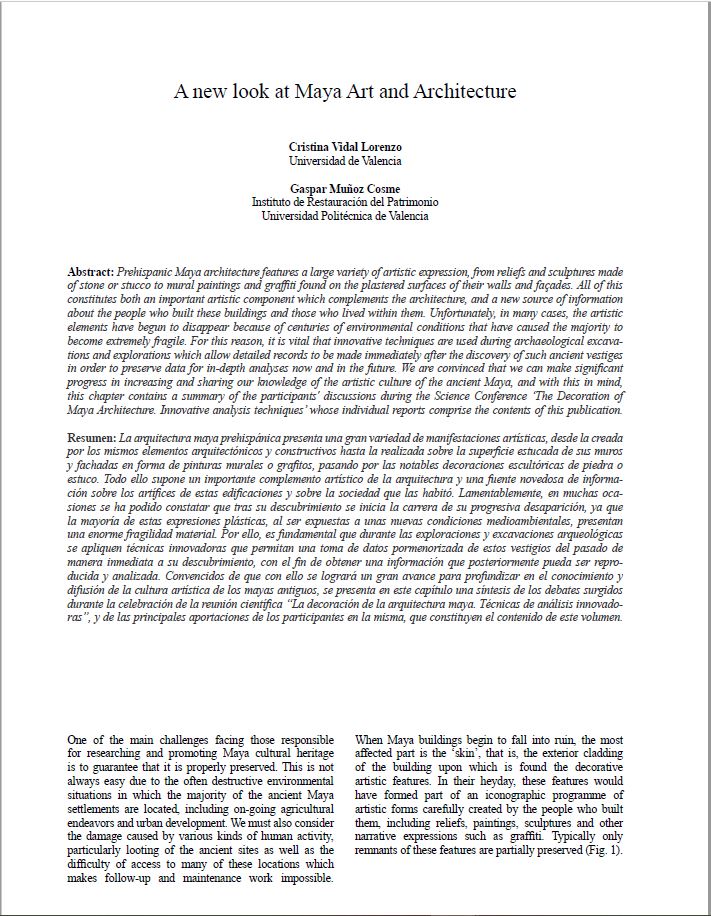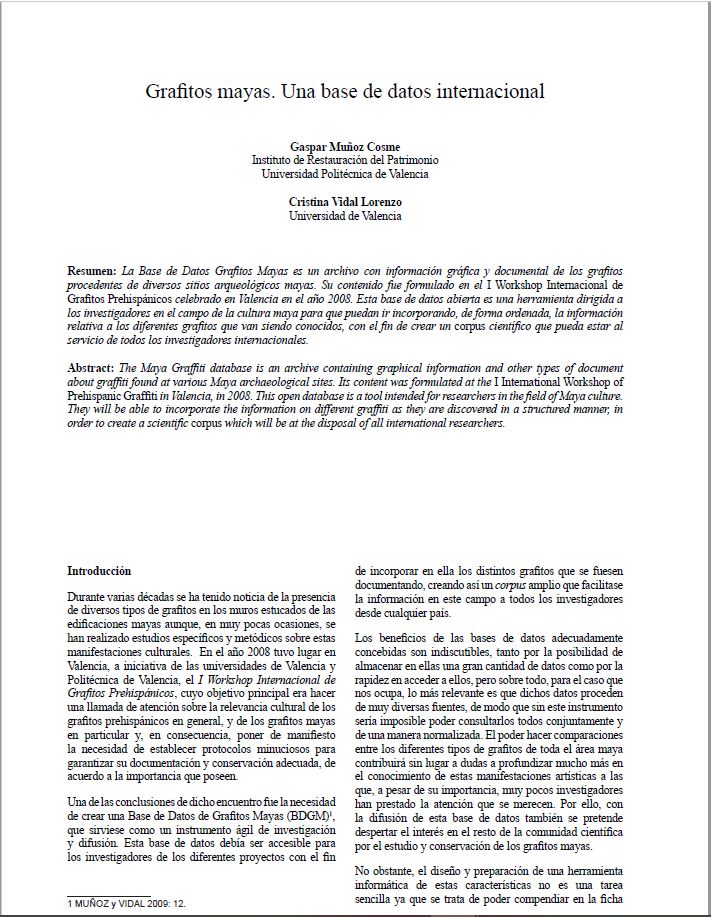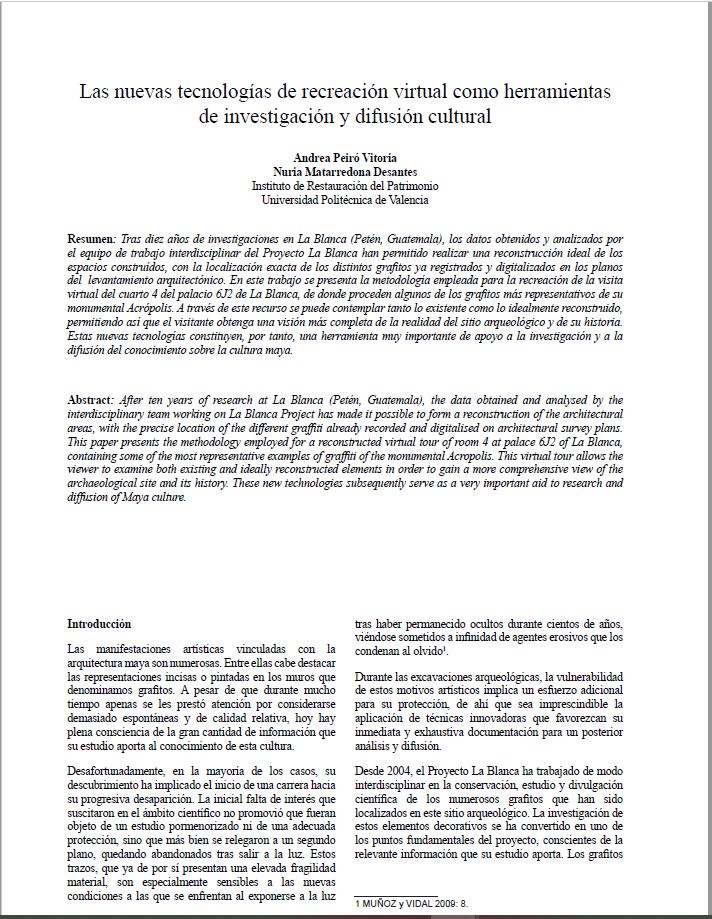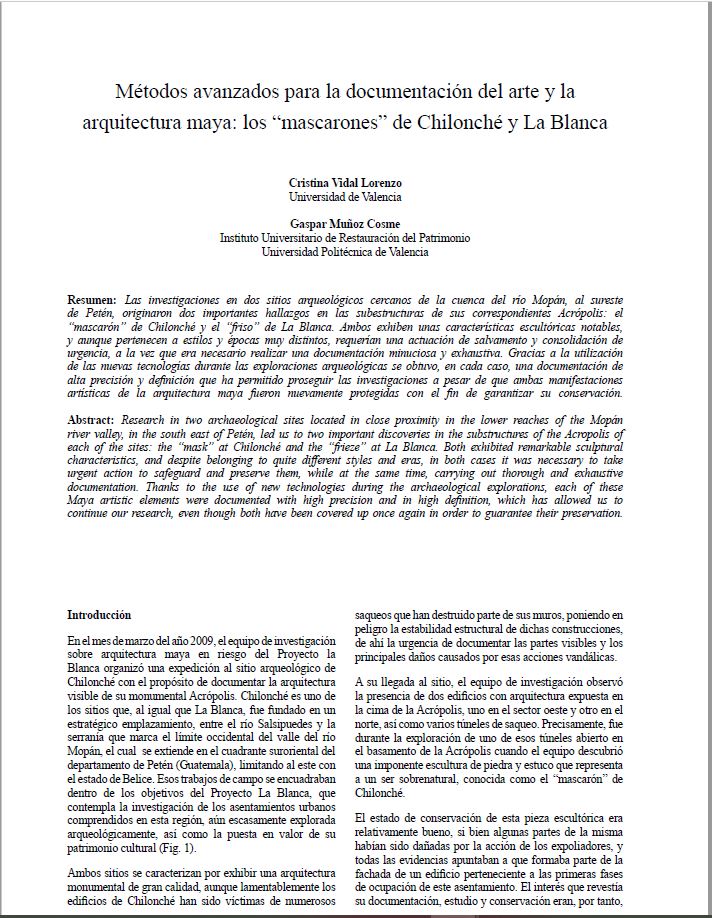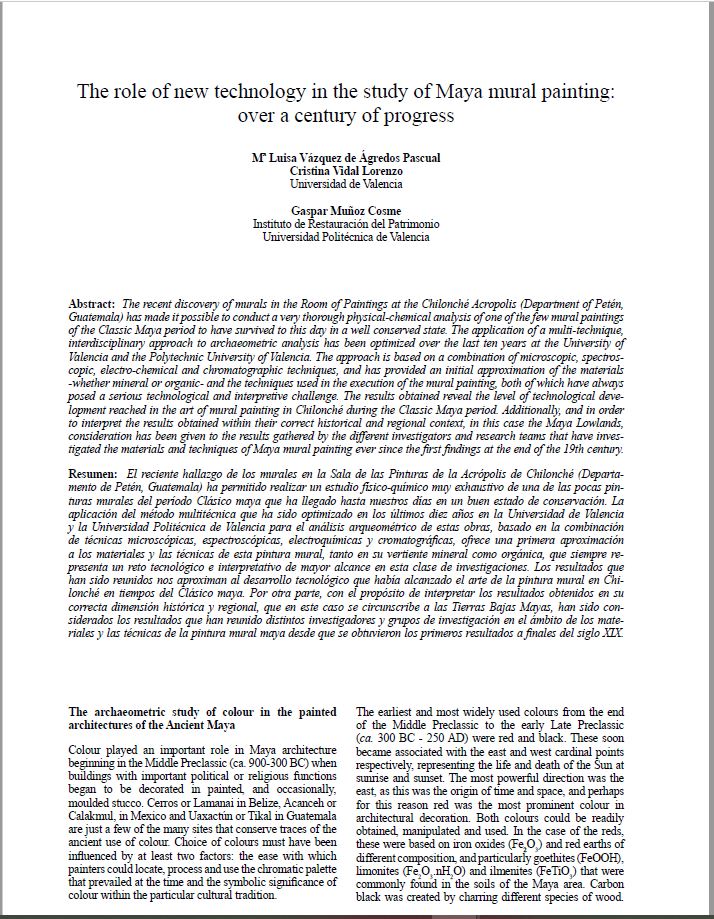
Artistic Expressions in Maya Architecture: Analysis and Documentation Techniques
Vidal Lorenzo, Cristina, and Gaspar Muñoz Cosme. 2014. “A New Look at Maya Art and Architecture.” In Artistic Expressions in Maya Architecture: Analysis and Documentation Techniques, edited by Cristina Vidal Lorenzo and Gaspar Muñoz Cosme, 7–12. Oxford: Archaeopress. Publishers of British Archaeological Reports.
Prehispanic Maya architecture features a large variety of artistic expression, from reliefs and sculptures made of stone or stucco to mural paintings and graffiti found on the plastered surfaces of their walls and façades. All of this constitutes both an important artistic component which complements the architecture, and a new source of information about the people who built these buildings and those who lived within them. Unfortunately, in many cases, the artistic elements have begun to disappear because of centuries of environmental conditions that have caused the majority to become extremely fragile. For this reason, it is vital that innovative techniques are used during archaeological excavations and explorations which allow detailed records to be made immediately after the discovery of such ancient vestiges in order to preserve data for in-depth analyses now and in the future. We are convinced that we can make significant progress in increasing and sharing our knowledge of the artistic culture of the ancient Maya, and with this in mind, this chapter contains a summary of the participants’ discussions during the Science Conference ‘The Decoration of Maya Architecture. Innovative analysis techniques’ whose individual reports comprise the contents of this publication.
Muñoz Cosme, Gaspar, and Cristina Vidal Lorenzo. 2014. “Grafitos Mayas. Una Base de Datos Internacional.” In Artistic Expressions in Maya Architecture: Analysis and Documentation Techniques, edited by Cristina Vidal Lorenzo and Gaspar Muñoz Cosme, 13–18. Oxford: Archaeopress. Publishers of British Archaeological Reports.
La Base de Datos Grafitos Mayas es un archivo con información gráfica y documental de los grafitos procedentes de diversos sitios arqueológicos mayas. Su contenido fue formulado en el I Workshop Internacional de Grafitos Prehispánicos celebrado en Valencia en el año 2008. Esta base de datos abierta es una herramienta dirigida a los investigadores en el campo de la cultura maya para que puedan ir incorporando, de forma ordenada, la información relativa a los diferentes grafitos que van siendo conocidos, con el fin de crear un corpus científico que pueda estar al servicio de todos los investigadores internacionales.
Peiró Vitoria, Andrea, and Nuria Matarredona Desantes. 2014. “Las Nuevas Tecnologías de Recreación Virtual Como Herramientas de Investigación Y Difusión Cultural.” In Artistic Expressions in Maya Architecture: Analysis and Documentation Techniques, edited by Cristina Vidal Lorenzo and Gaspar Muñoz Cosme, 57–69. Oxford: Archaeopress. Publishers of British Archaeological Reports.
Tras diez años de investigaciones en La Blanca (Petén, Guatemala), los datos obtenidos y analizados por el equipo de trabajo interdisciplinar del Proyecto La Blanca han permitido realizar una reconstrucción ideal de los espacios construidos, con la localización exacta de los distintos grafitos ya registrados y digitalizados en los planos del levantamiento arquitectónico. En este trabajo se presenta la metodología empleada para la recreación de la visita virtual del cuarto 4 del palacio 6J2 de La Blanca, de donde proceden algunos de los grafitos más representativos de su monumental Acrópolis. A través de este recurso se puede contemplar tanto lo existente como lo idealmente reconstruido, permitiendo así que el visitante obtenga una visión más completa de la realidad del sitio arqueológico y de su historia. Estas nuevas tecnologías constituyen, por tanto, una herramienta muy importante de apoyo a la investigación y a la difusión del conocimiento sobre la cultura maya.
Vidal Lorenzo, Cristina, and Gaspar Muñoz Cosme. 2014. “Métodos avanzados para la documentación del arte y la arquitectura maya: los ‘mascarones’ de Chilonché y La Blanca” In Artistic Expressions in Maya Architecture: Analysis and Documentation Techniques, edited by Cristina Vidal Lorenzo and Gaspar Muñoz Cosme, 75–90. Oxford: Archaeopress. Publishers of British Archaeological Reports.
Las investigaciones en dos sitios arqueológicos cercanos de la cuenca del río Mopán, al sureste de Petén, originaron dos importantes hallazgos en las subestructuras de sus correspondientes Acrópolis: el “mascarón” de Chilonché y el “friso” de La Blanca. Ambos exhiben unas características escultóricas notables, y aunque pertenecen a estilos y épocas muy distintos, requerían una actuación de salvamento y consolidación de urgencia, a la vez que era necesario realizar una documentación minuciosa y exhaustiva. Gracias a la utilización de las nuevas tecnologías durante las exploraciones arqueológicas se obtuvo, en cada caso, una documentación de alta precisión y definición que ha permitido proseguir las investigaciones a pesar de que ambas manifestaciones artísticas de la arquitectura maya fueron nuevamente protegidas con el fin de garantizar su conservación.
May Castillo, Manuel, and Beatriz Martín Domínguez. 2014. “Aplicación de técnicas fotogramétricas en el estudio de la arquitectura maya” In Artistic Expressions in Maya Architecture: Analysis and Documentation Techniques, edited by Cristina Vidal Lorenzo and Gaspar Muñoz Cosme, 91–107. Oxford: Archaeopress. Publishers of British Archaeological Reports.
Durante los años 2009 y 2010, el equipo de investigación en Patrimonio Cultural y Cooperación para el Desarrollo del Instituto Universitario de Restauración del Patrimonio de la Universidad Politécnica de Valencia ha llevado a cabo el levantamiento arquitectónico de varios edificios en algunos asentamientos urbanos mayas del Noreste de Petén, utilizando técnicas de restitución fotogramétrica, lo cual ha permitido registrar con precisión milimétrica el estado de las superficies de muros y bóvedas. Asimismo ha posibilitado la reproducción exacta de sus elementos decorativos, tales como pinturas murales y grafitos, y el estudio de las patologías existentes en el momento de la toma de datos. En este sentido, el método fotogramétrico resulta de gran ayuda dado el peligro al que se encuentra expuesto el patrimonio cultural maya. Tanto las condiciones ambientales extremas como el expolio arqueológico constituyen serias amenazas para su preservación, siendo especialmente sensibles a estos riesgos los elementos decorativos que exhiben sus superficies, de ahí la importancia de emprender un adecuado registro y documentación de estas arquitecturas.
Vázquez-de-Ágredos Pascual, Maria Luisa, Cristina Vidal Lorenzo, and Gaspar Muñoz Cosme. 2014. “The Role of New Technology in the Study of Maya Mural Painting: Over a Century of Progress.” In Artistic Expressions in Maya Architecture: Analysis and Documentation Techniques, edited by Cristina Vidal Lorenzo and Gaspar Muñoz Cosme, 165–78. Oxford: Archaeopress. Publishers of British Archaeological Reports.
The recent discovery of murals in the Room of Paintings at the Chilonché Acropolis (Department of Petén, Guatemala) has made it possible to conduct a very thorough physical-chemical analysis of one of the few mural paintings of the Classic Maya period to have survived to this day in a well conserved state. The application of a multi-technique, interdisciplinary approach to archaeometric analysis has been optimized over the last ten years at the University of Valencia and the Polytechnic University of Valencia. The approach is based on a combination of microscopic, spectroscopic, electro-chemical and chromatographic techniques, and has provided an initial approximation of the materials -whether mineral or organic- and the techniques used in the execution of the mural painting, both of which have always posed a serious technological and interpretive challenge. The results obtained reveal the level of technological development reached in the art of mural painting in Chilonché during the Classic Maya period. Additionally, and in order to interpret the results obtained within their correct historical and regional context, in this case the Maya Lowlands, consideration has been given to the results gathered by the different investigators and research teams that have investigated the materials and techniques of Maya mural painting ever since the first findings at the end of the 19th century.
Doménech Carbó, Antonio, María Teresa Doménech Carbó, Cristina Vidal Lorenzo, and Maria Luisa Vázquez-de-Ágredos Pascual. 2014. “Maya Blue (‘Maya Green’ and ‘Maya Yellow’): New Insights into the Maya Blue Technology.” In Artistic Expressions in Maya Architecture: Analysis and Documentation Techniques, edited by Cristina Vidal Lorenzo and Gaspar Muñoz Cosme, 179–208. Oxford: Archaeopress. Publishers of British Archaeological Reports.
The recent use of electrochemical techniques, combined with microscopy and spectroscopic techniques, have led to considerable advances in the study of Maya Blue. These advances include the detection of pigment in wall paintings at the Substructure IIC of Calakmul, dated as the Late Preclassical period, and notably bringing forward the use of the pigment. Chemometric analysis of Maya Blue samples from different sites suggest that the preparation procedure of Maya Blue probably changed over time following a branched pattern. More recent analysis on yellow samples from wall paintings in several archaeological sites in Yucatán and Campeche has shown the presence of indigoid compounds, including isatin and dehydroindigo, attached to palygorskite, forming a ‘Maya Yellow’ material. Analytical studies on a set of spherical pellets discovered at Structure 4H1 of La Blanca (Petén, Guatemala) confi rm the presence of indigo and its alteration products associated with palygorskite and suggest that the ancient Mayas could prepare indigo, Maya Blue and related green and yellow pigmenting materials in different stages from a common preparative procedure. This process, which would undergo local variations during the different periods of the Maya culture, show a command over Maya Blue technology of great significance throughout time.

